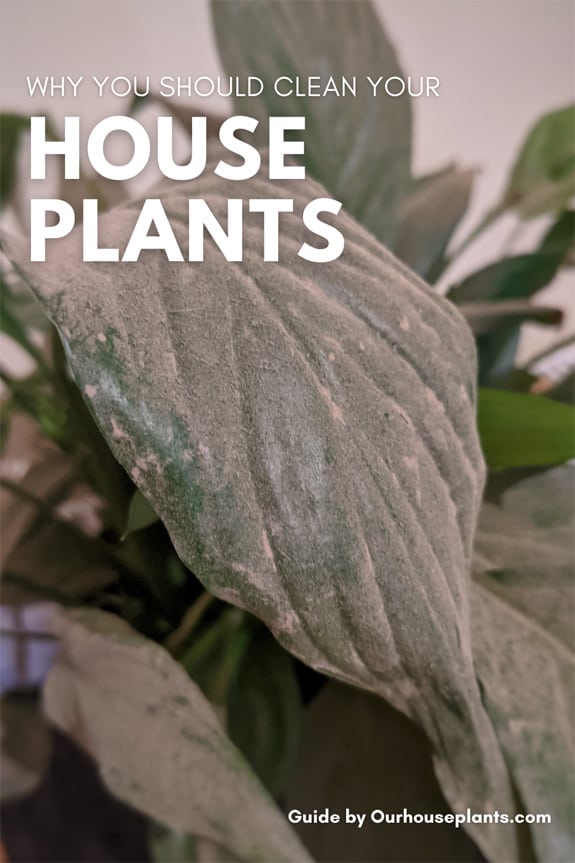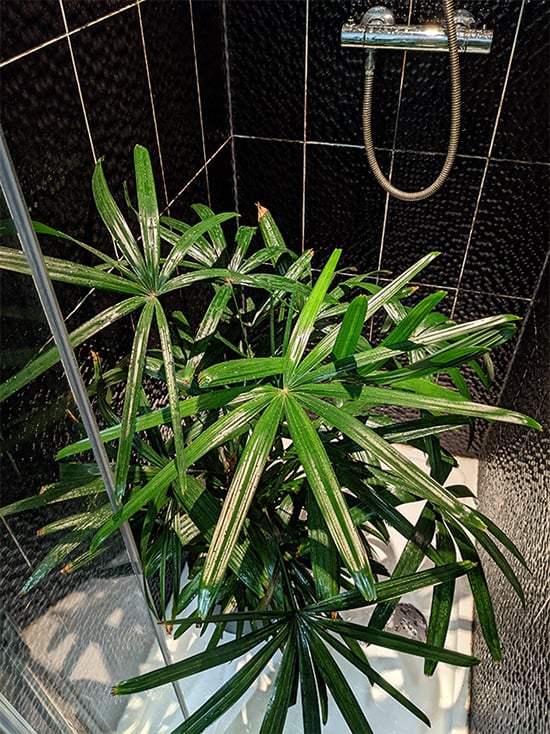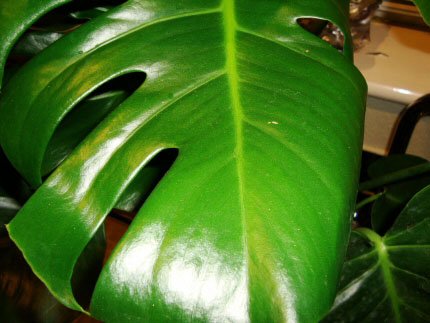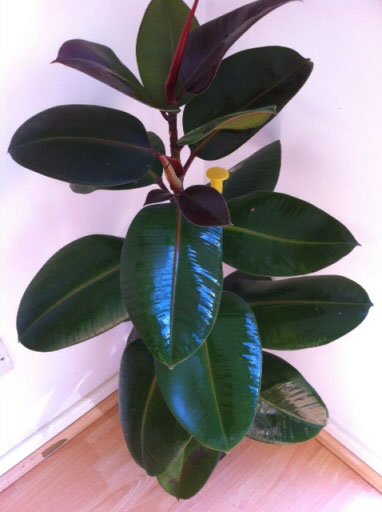Houseplants need to be cleaned occasionally. After all, they accumulate dust just like everything else in our home.
Spending some time every couple of months doing a little cleaning will help keep your plants healthy and looking fantastic.

A Peace Lily leaf covered in a thick layer of dust. It's crying out for a soft microfiber cloth or a lukewarm shower to clean those dirty leaves.
My guide explains why cleaning plants shouldn't be neglected and why leaf cleaning has beneficial effects.
You'll then learn the various techniques to clean them and which method is best for which type of plant. I'll also deal with leaf shining and what to avoid.
Cleaning houseplants offers several benefits to both the plants and the environment they're growing in.

Hi, I'm Tom!
If you're like me and enjoy the challenge of growing houseplants and getting them to thrive, then Ourhouseplants can help. This website shares my knowledge and years of growing plants and provides (hopefully) helpful advice on properly caring for your indoor plant friends.
This may seem like a silly part of the guide because everyone knows how to clean plants, right?
But there are actually quite a few different ways you can do it. Sometimes certain methods are better than others depending on the plant.

Over time, many houseplants will attract dust and mineral deposits. However they're often easy to remove by giving the dirty leaves a quick wash in the shower.
The foliage on many houseplants will take on a dull looking sheen over time. Even if the plants are cleaned regularly and are free from dust, they can still lose the glossy shine found on new leaves.
This dulling effect is natural and not a sign you are doing something wrong. Although many people will leave their plant to it, so really love that new shine look.
Extra Tip
The best way to improve the look of an indoor plant is sometimes as simple as removing any brown or dried leaves and cutting off any brown tips or spent flower stems.
Shiny leaves are often considered the pinnacle of a well-groomed and beautiful-looking plant. There are hundreds of leaf shine products you can buy and several Do It Yourself varieties.
But are they a good thing, are they suitable for all plants and how should they be applied?
If you can cope with the smell, then a homemade Neem Oil spray is potentially one of the best things you can use. It helps protect your plants from pests and can give a long lasting shine to the leaves.
Milk and beer are often recommended as "natural" products to give shine, but in truth they have virtually no shine-producing abilities above using just plain water.

Using leaf shine on this Monstera has given it a remarkable shine.
Mineral oil and olive oil are sometimes suggested as natural plant cleaning products. While they can produce remarkable shine on the leaves of your plants you'll only make more work for yourself in the long run.
This is because these substances are slightly sticky and become tacky when dried. This will then attract dust and cause it to settle on the leaf surface more than a plant that hasn't been treated.
I would gently put our hands on your shoulders and walk you away from jars of mayonnaise, yogurt and banana skins if I caught you entertaining any of these ideas.
You might get the shine you are looking for, but pull back a little and allow us to point out that people don't use these things to clean their work surfaces and they shouldn't be used on plants either.
Again they will attract more dust, possibly ruin the appearance of the leaves in the long term. Additionally all of these products will go "off" and feed bacteria. It's unhygienic to have the residual waving around on the leaves you have just wiped down.
Remember that leaf shining is optional. However the best results long lasting results will usually come from a chemical product.
They typically come in either an aerosol form, which is good for plants with lots of small leaves, or as a liquid which is better for plants with bigger leaves.
Leaf shine is safe for many plants, however check our individual plant pages if you want to be certain. If you shouldn't be using it I'll tell you.
Cleaning the leaves of your houseplants sounds simple (and it really is) but there are a few things you should avoid doing.

You can use leaf shine to polish the dusty leaves of a Rubber Plant too. But there are some things you should avoid doing when using these products.
If you've got a question not answered below drop it into the comments and I'll get it added.
Commercial leaf shine products have been tested on plants and if you follow the instructions carefully most will clean your plant leaves as well as leaving a nice shine. If you want something natural, or that doesn't cost very much, then a good old damp cloth is the way to go.
Some people will use banana peel, oils, milk, or even mayo to give leaves a natural shine. However I don't and I won't recommend this to you. You're putting food residue on leaves, which will only encourage bacteria to form.
A damp cloth or running a shower over the leaves will remove dust and grime allowing a natural shine.
Neem oil is primarily used as a natural insecticide and fungicide to control pest infestations and plant diseases. It can however be used on a healthy plant to help keep leaves clean and give them a shine at the same time.
However you must only use a really small amount and ensure it's diluted with clean water and a drop of dish soap. Why? Well Neem is pretty oily, you don't want to create a greasy leaf by using too much as this will just make it easier for dust to stick to the leaves.